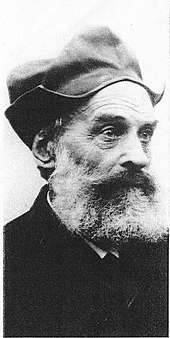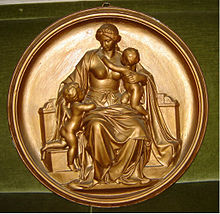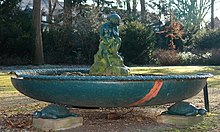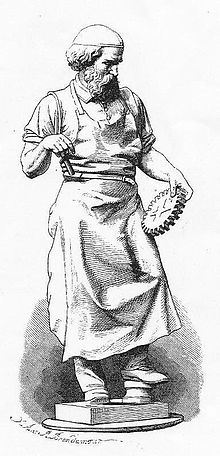Diedrich Samuel Kropp
Diedrich Samuel Kropp (born December 15, 1824 in Bremen ; † May 15, 1913 there ) was a German sculptor .
biography
Kropp was the son of a kimker and brandy distiller. The father died in 1838 when the son was only 14 years old. After school, Kropp was first an errand boy, then an assistant draftsman for a geometer and then assistant to a ship's carpenter. From 1844 to 1848 he learned the carpentry trade in Bremen and Hamburg .
artistic education
Kropp received his first suggestions for artistic design as a wood sculptor and ship carver in Rostock and from 1849 to 1851 in Bremen from the sculptor Heinrich Frese (1794-1869), where he worked in this creative trade without any special training. His talent was noticed in the Freses workshop when Senator Arnold Duckwitz inspected a new ship.
With the help of a scholarship , Kropp was able to attend the Academy of Fine Arts in Munich in 1851 and 1852 . There he studied for a year drawing from nature and living models with Johann Baptist Berdellé and at the same time, as a student of Max von Widnmann, attended courses on introductory sculpture.
At the end of 1852 Kropp switched to the Art Academy in Dresden , where two late exponents of the Canova style, which was oriented towards antiquity , Ernst Rietschel (a student of Rauch ) and Ernst Hähnel , had founded a recognized school of sculpture.
After a brief activity in Rietschel's studio , Kropp switched to Ernst Hähnel, with whom he worked for four years until 1858. In addition, Kropp created his first independent work of art in Dresden, a marble medallion Caritas , which was purchased by the Dresden Art Association.
In 1858 Kropp returned briefly to Bremen and carved his first free-standing large figure in sandstone for the grave site of the cathedral organist and founder of the Singakademie, Wilhelm Friedrich Riem , an internalized muse of mourning in the form of St. Cäcilie, who was assigned the attribute of the organ indicated the services of the deceased to Bremen music care.
Stay in Rome
In the fall of 1858, Kropp took the opportunity to expand his artistic conception in Rome with the help of a three-year scholarship of 80 thalers per year, which was awarded by the Bremen Senate the previous year . In Rome he let the evidence of antiquity work on him and took an active part in the cultural life, which was particularly influenced by Peter von Cornelius . The friendship with Hermann Allmers , which lasted a lifetime , began in a society that included the Oldenburg painter Ernst Willers , the Glückstadt philologist Detlef Detlefsen and the Jenenser zoologist Ernst Haeckel .
While in Rome, Kropp was still busy with the sketch for a Schiller monument and with a Schiller bust that, according to the sculptor's idea, was to be set up in the Bremen ramparts in front of the Abbentor. He also worked on a bust of Christ and a plastic boy who fell asleep fishing . After Kropp had unsuccessfully sent two of his works to Bremen for sale, his financial situation deteriorated so much that he could no longer buy any material and consequently could no longer carry out any further work in Rome. After the end of the scholarship, Kropp was forced to leave the place of his studies in early 1861.
In spring 1861 Kropp returned to Bremen - at the age of 36 - and had a rather modest workshop here.
Building an artistic existence
Kropp's efforts to get lucrative sculpting jobs, e.g. B. with the architect Heinrich Müller , initially had little success. So he planned to leave Bremen again to live as an artist in Dresden. But the request to create a larger-than-life, fully plastic sandstone figure of an evangelist Luke for the facade of the artists' association building on Domsheide, designed and already completed by Müller , and the prospect of delivering four statues for the new stock exchange building on the market square in Bremen, kept Kropp in his hometown . This is how the long-standing friendship with the master builder Heinrich Müller came about, which Kropp secured numerous lucrative commissions for the design of buildings with plastic jewelry in the second half of the 19th century. Kropp soon moved away from the idealistically exaggerated formal language of the art of Carl Steinhauser and met the artistic demands of his time with his rather realistic, but masterful approach to the design of the figures.
The great reputation that Kropp soon enjoyed as a sculptor earned him an honorable appointment to a commission for the purchase of collection items in mid-1862.
The main work
Kropp, who worked alone, was faced with a huge task when Heinrich Müller's concept for the new construction of the New Stock Exchange on the market was approved for implementation by the Bremen Chamber of Commerce . This job took up all of his creative power. The architect planned rich figurative decorations for the two main entrances to the market square and the cathedral. The portal facing north was to receive allegorical sculptures in addition to a coat of arms decoration. In the middle gusset, seated sculptures of the ocean and the Weser were to be used as shield holders, and symbols of industry and peace were to be depicted in the corner gussets. For this purpose standing statues of land and sea traffic had to be created to the side of the portal. Apart from the scope, the artistic task of giving the figures expressiveness through attributes was also an enormous challenge.
Further work
He created a number of mostly allegorical figures, religious figures, historical statues, portraits, tombs and working people. The corner figures of Roman warriors on the balustrade of Bremen's town hall , figures on the Bacchus barrel in the Bremen Ratskeller , the figures of music and dance on the Hollersee near Bremen's public park , motifs in the spandrels at Bremen's main train station , the artisan's fountain and tombs in the Riensberg cemetery have been preserved and Walle. There are also works by him in and on private houses in Bremen. Part of his estate was in the Focke Museum in Bremen , where it was destroyed.
After Kropp had criticized the violations of Wilhelm Benque's plans to build the Bürgerpark in 1876 , he was elected to the committee of the Bürgerparkverein, of which he was a member for 36 years until his death. He also took part in various collection campaigns, such as in 1879 and 1883 to raise funds for the completion of the public park, but also took a position against Benque when he was released in 1884.
Kropp won loyal friends through his reserved, elegant and pure demeanor, his rich work and his devotion to art and his ideals of beauty found widespread recognition. In aesthetic questions, e.g. B. on the board of the art association, his calm, weighing advice was asked. At the end of 1909, Diedrich Samuel Kropp celebrated his 85th birthday with great respect, and the Senate honored him with a letter of congratulations and a gift of twenty bottles from the Bremen Ratskeller .
Kropp died on May 15, 1913 at the age of 89 in a spirit of freshness. His remains were cremated and the urn was buried next to the grave of his friend Heinrich Müller, who had died 23 years earlier, in the Riensberg cemetery in Bremen.
Quick forgetting
Even if the daily newspapers also devoted appreciative obituaries to the deceased Kropp, the promise of the Weser-Zeitung of 1904 to keep him an honorable memory for all time was not kept. One example is the Bremen biography 1912–1962, in which this extraordinarily talented man from Bremen is missing. His works did not fare much better. The Kropp works in the possession of the Bremen Kunsthalle were not regarded as worth keeping, so that Kropp is no longer represented in the collections of the renowned Bremen cultural institute.
Works
- 1858: Large figure Muse of Mourning for Wilhelm Friedrich Riem's grave in sandstone
- 1861–1864: stone figures on the new stock exchange on Bremen market square (not preserved)
- 1865: Germania figure on the fairground of the second German shooting festival
- around 1870: corner figures of Roman warriors on the balustrade of the Bremen town hall , figures on the Bacchus barrel in the Bremen Ratskeller
- 1877: Altmann bust in the marble ramparts near the Doventor bastion, destroyed in 1944; the copy of a bronze bust has stood at the Ansgari bastion since 2003.
- after 1878: Memorial of Christian Rutenberg, murdered son of Lüder Rutenberg , in a mausoleum in the Riensberg cemetery , (grave number AA 17/25)
- 1880: Jesus statue by the mausoleum in the Waller cemetery
- around 1880: bust of Wilhelm Hertzberg in the old grammar school
- 1884: Bust of Ernst Heinrich Kahrweg in the garden of the Landhaus Horn foundation residence in Schwachhausen
- around 1888: The stone reliefs of the allegories on the corner pillars of the facade of Bremen Central Station
- 1889: Marcus-Brunnen (Bürgerpark) , the figures in bronze
- 1896: Medallion portrait of Kurt von Goessel in bronze in Goesselstraße, Findorff , on a wall.
literature
- Harry Schwarzwälder : Life and Work of the Sculptor Diedrich Samuel Kropp - 1824-1913. In: Information sheet of the Bürgerparkverein Bremen, Bremen 1998.
- Harry Black Forest: Diedrich Samuel Kropp. In: Information sheet of the Bürgerparkverein Bremen, pp. 30–38, Bremen 1997
- Harry Schwarzwälder: A forgotten sculptor from Bremen. In: A. Behne, O. Gradel (ed.): Being human and using people. Hermann Allmers and his artist friends: Catalog for the exhibition in the 100th year of death of Hermann Allmers , Verlag Landkreis Cuxhaven, June 2002, ISBN 393410004X
Individual evidence
- ↑ a b Herbert Schwarzwälder : The Great Bremen Lexicon . 2nd, updated, revised and expanded edition. Edition Temmen, Bremen 2003, ISBN 3-86108-693-X .
- ^ Message from the press office of the Senate from 2003: Isaak Hermann Albert Altmann successfully cloned .
Web links
| personal data | |
|---|---|
| SURNAME | Kropp, Diedrich Samuel |
| BRIEF DESCRIPTION | German sculptor |
| DATE OF BIRTH | December 15, 1824 |
| PLACE OF BIRTH | Bremen |
| DATE OF DEATH | May 15, 1913 |
| Place of death | Bremen |




